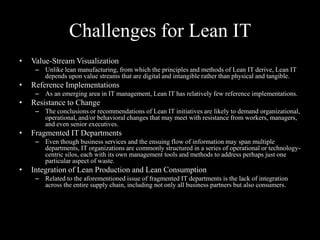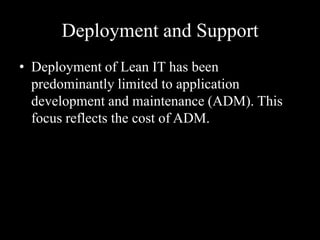Lean Information Technology (Lean IT) applies lean manufacturing principles to reduce waste in IT development and management. It aims to identify and eliminate non-value adding activities. Lean IT focuses on value streams, value-stream mapping, continuous flow and pull-based demand systems. Implementation begins by mapping key IT value streams. Lean IT draws from various frameworks like ITIL, Agile, Six Sigma and CMMI but is a philosophy rather than a prescribed methodology. Recessionary pressures, online transactions and green initiatives are increasing interest in Lean IT.
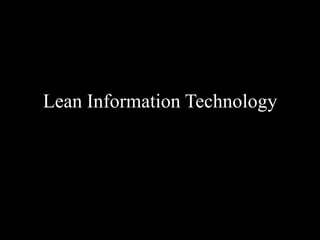






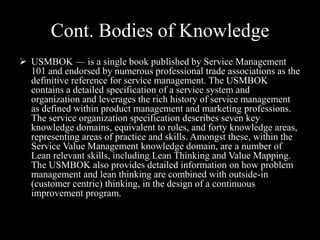






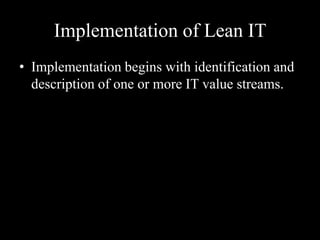
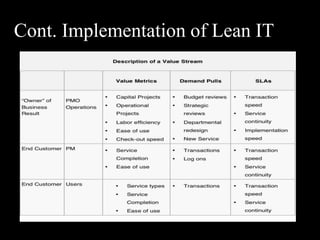
![Trends towards Lean IT
•
Recessionary Pressure to Reduce Costs
–
•
Lean IT can expect to garner support during economic downturns as business leaders seek initiatives that deliver more enduring
value than is achievable through reactive and generalized cost-cutting.
Proliferation of Online Transactions
–
IT has traditionally been a mere support function of business, in common with other support functions such as Finance and
accounting.
•
•
•
•
•
•
•
–
The prevalence of web-based transactions is driving a convergence of IT and business
•
•
•
•
IT services are increasingly central to the mission of providing value to customers
Lean IT initiatives are accordingly becoming less of a peripheral interest
intrinsic interest to the core business.
Green IT
–
–
•
mission-critical business functions to the Web.
leverage investments in service-oriented architectures
decrease costs
improve efficiency
increase access to customers
partners
Employees.
initiatives are congruent with a broad movement towards conservation and waste reduction
Waste reduction directly correlates with reduced energy consumption and carbon generation.
Indeed, IBM asserts that IT and energy costs can account for up to 60% of an organization's capital expenditures
and 75% of operational expenditures.[26] In this way, identification and streamlining of IT value streams supports
the measurement and improvement of carbon footprints and other green metrics.[27] For instance, implementation
of Lean IT initiatives is likely to save energy through adoption of virtualization technology and data center
consolidation.[28][29]](https://image.slidesharecdn.com/leanit-131212173427-phpapp02/85/Lean-Information-Technology-17-320.jpg)
